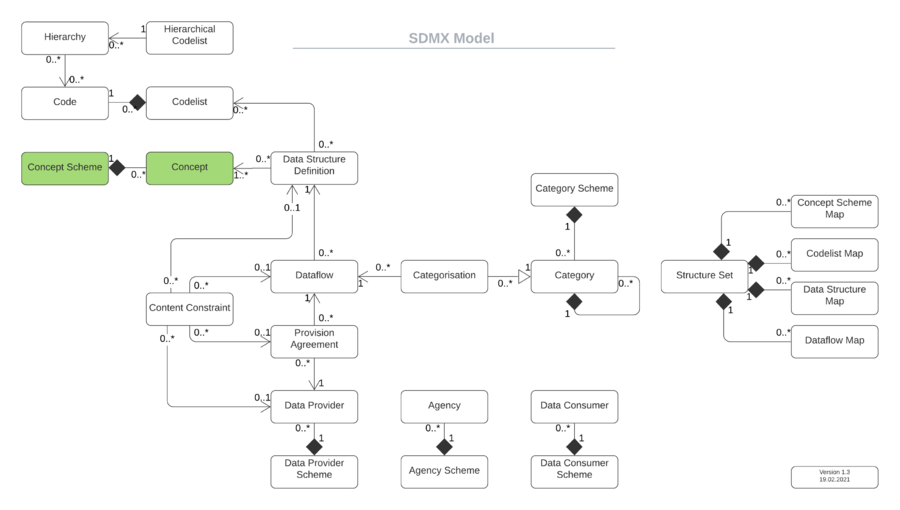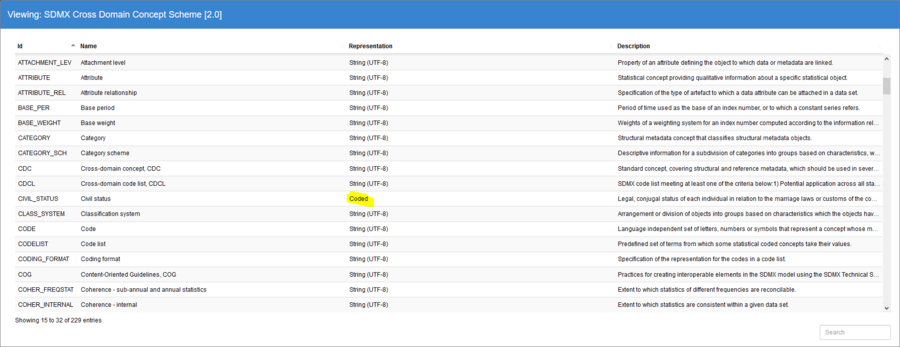Difference between revisions of "Concept Scheme V10"
(→Overview) |
(→Usage) |
||
| Line 47: | Line 47: | ||
[[File:Concept2A.PNG|900px]] | [[File:Concept2A.PNG|900px]] | ||
| + | |||
| + | Note that the concept '''Civil Status''' has been coded and references the Codelist '''CIVIL_STATUS''', viewing that Codelist displays valid codes. | ||
| + | |||
| + | [[File:Concept3.PNG|900px]] | ||
| + | |||
| + | '''Using standardised Concepts wherever possible is good practice because it enables harmonisation of statistics i.e. it’s easy to compare statistics produced by different organisations if referenced concepts mean the same thing.''' | ||
| + | |||
| + | ==Context within the SDMX 2.1 Information Model== | ||
| + | [[File:Concept1.png|900px]] | ||
==Conventions== | ==Conventions== | ||
Revision as of 03:44, 10 February 2021
Contents
Overview
A concept scheme is a container for Concepts. A concept associates an identifier with a name and optional description. Their purpose is to provide other structures a semantic meaning.
Concepts may be referenced by multiple structures in SDMX, and therefore provide re-useable mechanism for giving meaning to structures.
A Data Structure Definition (DSD) provides a good example of how Concepts are used as to create a DSD. When defining a Data Structure Definition, each Dimension, Attribute and Measure is given a specific Concept. The dimensions etc do not have names or descriptions, instead they provide a reference to a Concept which gives this information. In order to get a human readable name for a Dimension, the referenced Concept must first be obtained.
Structure Properties
| Structure Type | Standard SDMX Structural Metadata Artefact |
|---|---|
| Maintainable | Yes |
| Identifiable | Yes |
| Item Scheme | Yes |
| SDMX Information Model Versions | 1.0, 2.0, 2.1 |
| URN - ConceptScheme namespace | urn:sdmx:org.sdmx.infomodel.conceptscheme.ConceptScheme |
| URN - concept namespace | urn:sdmx:org.sdmx.infomodel.concept.Concept |
Context within the SDMX 2.1 Information Model
The schematic illustrates the core artefacts of the SDMX 2.1 Information Model, and how Concepts Schemes and Concepts fit in.
Concepts are referenced directly by Data Structure Definitions (DSD). Concepts can also be linked to Codelists to explicitly define the set of legal values for enumerated Dimensions or Attributes.
Usage
Concepts are used by Dimensions, Attributes, Measures, and Metadata Attributes to provide them with a semantic meaning. Concepts can also be used to define a default representation, for example it is possible to link the Concept of Frequency to a Codelist containing all the Frequency Codes, any structure using the Concept will inherit the default representation.
The SDMX Cross Domain Concept Scheme provides a range of standardised Concepts maintained by the SDMX Statistical Working Group (SWG) and can be viewed on the Global Registry site https://registry.sdmx.org/items/conceptscheme.html.
An extract is shown below.
Note that the concept Civil Status has been coded and references the Codelist CIVIL_STATUS, viewing that Codelist displays valid codes.
Using standardised Concepts wherever possible is good practice because it enables harmonisation of statistics i.e. it’s easy to compare statistics produced by different organisations if referenced concepts mean the same thing.
Context within the SDMX 2.1 Information Model
Conventions
Concept Scheme IDs IDs are conventionally uppercase using underscores '_' as separators if required. Examples:
| Agency | Concept Scheme ID | Description | SDMX-ML |
|---|---|---|---|
| ESTAT | CS_NA | List of concepts for National Accounts DSDs | SDMX-ML |
| UIS | CS_BOP | Balance of Payments Concept Scheme | SDMX-ML |
| IMF | CS_EDUC_UOE | EDUC_UOE Concept Scheme | SDMX-ML |
| SDMX | CROSS_DOMAIN_CONCEPTS | SDMX Gross Domain Concept Scheme | SDMX-ML |
You can seem more examples and information on Identities in this article.


